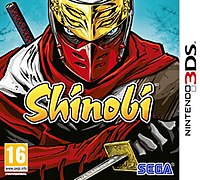Shinobi (2002 video game)
- For the 1987 arcade game of the same name, see Shinobi. For an overview of the series, see Shinobi series.
| Shinobi | |
|---|---|
 | |
| Developer(s) | Overworks |
| Publisher(s) | Sega |
| Designer(s) | Kouichi Nomura (director), Takao Hirabayashi (main programming), Makoto Tsuchibayashi (lead designer). |
| Platform(s) | PlayStation 2 |
| Release | November 12 2002 (USA) December 5 2002 (Japan) May 14 2003 (Europe). |
| Genre(s) | Action |
| Mode(s) | Single player |
Shinobi is a video game in the Shinobi series for PlayStation 2, developed by Overworks and published by Sega. It was originally released in the US on November 12 2002. The game harkens back to the original Shinobi games of the early 1990's, and its plot follows the exploits of a ninja called Hotsuma, the last member of the famed Oboro clan. Although the game succesfully revived the Shinobi franchise, it has remained somewhat controversial due to its extreme difficulty.
Story
Raised together within the Oboro Clan, Hotsuma and Moritsune were seldom apart during their youth. Being the younger of the two, Hotsuma looked up to Moritsune, and considered his older brother to be a superior warrior.
Eventually, the Oboro Clan commandment was revealed to the two boys after they discovered Akujiki, the sword that would be used in the ritual to decide the clan's leader.
The commandment deems that the next clan leader must be determined by a duel to the death between the eldest clan heirs -- in this case, Moritsune and Hotsuma. Aware of their destiny, the brothers trained incessantly, instructed by their foster parent, Kobushi.
10 years passed as the brothers refined their techniques and honed their senses. The duel occurred beneath a full moon, and after a long exhausting fight, Hotsuma finally slew his brother. Not long after, a massive earthquake struck Tokyo, and a mysterious Golden Palace appeared in the center of the city.
With the appearance of the palace came the arrival of the powerful sorcerer Hiruko, who summoned hellspawn to wreak havoc upon the city, and all but destroyed the Oboro clan. The city's residents became paralyzed with fear. With the Oboro Clan ravaged and Tokyo on the verge of collapse, Hotsuma placed himself at the heart of the chaos, determined to reach the mysterious Golden Palace and avenge the death of his clan.
Gameplay
Secrets
Standard bonus features in Shinobi include a level select, access to movies from the game and additional difficulty levels to complete the game on.
A number of secrets in the game however can be unlocked by collecting the gold Oboro coins scattered throughout each stage. Collecting 30 or 40 Oboro coins for example rewards the player with the ability to play as Moritsune or Joe Musashi respectively. Playing as these characters produces an overall different gaming experience than with Hotsuma. Moritsune for example is stronger and quicker than his brother, but the Akujiki sword will drain his life faster. Joe Musashi on the other hand is mistakenly branded with a weaker katana attack(it is just as strong as Hotsuma's), but an unlimited supply of throwing knives. Furthermore, his life will not drain as Hotsuma's or Moritsune's does because he uses a different blade than the Akujiki sword.
Finally, collecting all 50 Oboro coins in the game gains the player access to a special VR stage.
Sequels
As a sequel to Shinobi, Sega released Nightshade/Kunoichi in 2004. The story follows a female ninja named Hibana, in a plot loosely related to the events of Shinobi. The game further improved upon the gameplay mechanics of the original, while offering an overall easier playing experience. For example checkpoints were added to each level to lighten difficulty, although it should be noted that Nightshade is still by no means an "easy" game.
Soundtrack
The music of Shinobi was written and composed by Fumie Kumatani, Teruhiko Nakagawa, Takayuki Maeda, Yutaka Minobe and Masaru Setsumaru. The soundtrack was released on December 5 2002 through Sten och Flod records. Full tracklisting is as follows:
|
|
|
Trivia
- Shinobi is one of three games in the Shinobi series to simply be called Shinobi, along with the original Shinobi on arcade and the first Shinobi installment for Game Gear.
- Between Shinobi and the last game in the series Shinobi Legions there was a gap of seven years (1995-2002).
- Shinobi was the first game in the series to be fully rendered in 3D. Previous titles were traditional sidescrolling action games.
- As with the release of Sonic Advance on Nintendo's GameBoy Advance, the transition of Shinobi to a rival console marked another break in the longstanding tradition of one of Sega's mascottes.